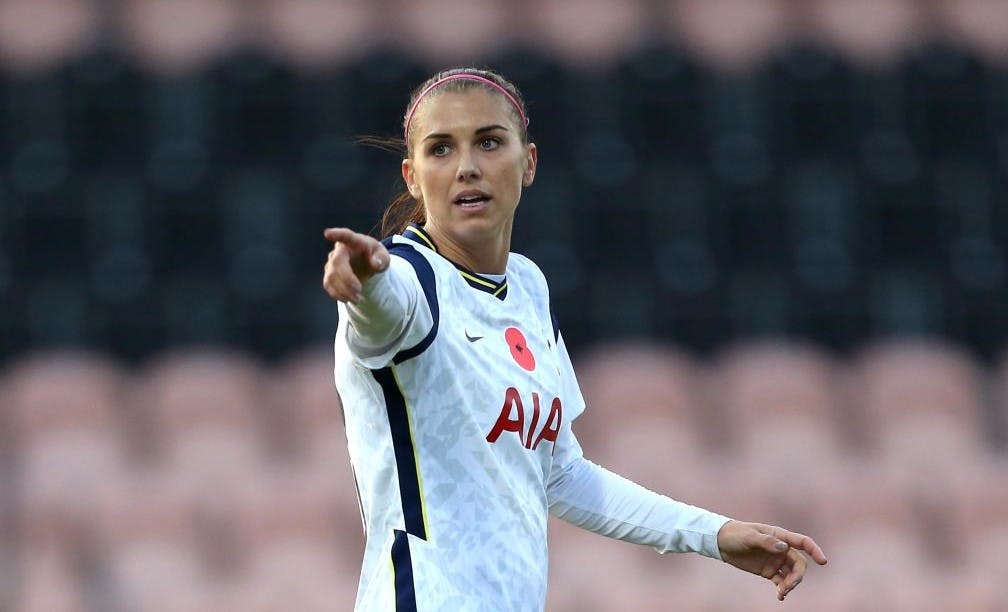
So, something unexpected happened in mid-September. My 13-year-old football and Tottenham-obsessed son came home buzzing. He was super-excited to find out Spurs had signed Alex Morgan. He was more excited than Gareth Bale’s signing a few days later. It felt important. It felt the women’s game was breaking through.
As someone who has been involved in the sports and media businesses for longer than I care to remember, I had not seen this heightened awareness of a women’s football star before.
A decade ago, I had played a small part in getting the precursor to the WSL on pay-TV when viewership was tiny and production values were an afterthought. Now, women’s footballers are becoming household names. It made me want to explore further what the future could hold for the women’s game.
Women’s football is at a crossroads. At the start of the year, it felt as though the stars were about to align, and the sport was about to take off like a rocket following the huge success of the 2019 Fifa Women’s World Cup, increased investment, and rising fan numbers and public interest. The sport offers a largely untapped market of open, self-aware and positive role models competing in games bristling with drama, personalities and emotions that can help to market any brand and which are attractive to both existing football fans and new demographics of fans.
This wave of increased awareness and interest has been created by a huge change in perception towards women in sport. A number of factors have driven this:
- Wider distribution and promotion of the major national team tournaments, aligned with more competitive professional club leagues and the increasing involvement of major (men’s club) brands
- A wave of scandals in female sports along with the rise of #MeToo movement has forced a (positive) change to protect athletes
- A new generation of media-savvy athletes using direct access to fans (social media) to build their brands more effectively
- The marketing push by sports brands who see the female market as a growing one for sales of sports shoes and apparel
The onset of Covid-19 was like a hitting a brick wall at speed. No doubt it’s a severe setback, however there are a number of indicators that, as the world of sport eventually learns to cope with this pandemic, and the sports business revs up again, growth will be strong.
The commercial reality is women’s football offers high (longer-term) return on investment and image for commercial partners and media. There is still a long way to go to compete with the men’s game both in audience and revenue, but neither the attitude change nor commercial benefits are going away.
I can see five factors pointing towards a bright future in women’s football:
- Sponsorship is growing
- Women’s football offers sport with purpose
- Media exposure (and reach)
- External investment interest
- Recognition by governing bodies

Sponsorship is growing
Sponsors look for engaged target audiences who can deliver brands a positive halo. The positivity and inclusion are there, and the numbers of fans engaging has been on the rise.
An additional advantage is that commercial rights in women’s football are not as clearly delineated by years of intensive commercialisation as with the men’s game, giving more flexibility and creativity in sponsorship agreements.
There is better access to players, more innovative campaign opportunities and a less cluttered commercial environment, giving brands more value for money than in many other sponsorships. Last year’s title sponsorship of the FA Women’s Super League (WSL) from Barclays included video highlights, match and player stats and a dedicated website, elements not included in traditional sponsorship packages. Barclays are also offering substantial prize money.
Standalone partnerships have also been created either with new brands to football, or partners extending to include and activate with women’s football. Vitality has launched its first ever football title sponsorship with the Vitality Women’s FA Cup. Budweiser is sponsoring the England Women’s team for the first time and Lucozade Sport has stepped up promotion of its association with the Lionesses. Further afield, Stanley Black & Decker expanded its FC Barcelona sponsorship to include front-of-shirt positioning with FC Barcelona Femení, something impossible to imagine a few years ago.
Internationally, Visa became Uefa’s first standalone women’s sponsor with a commitment to match marketing spend with that of its men’s sponsorship (and were followed by Pepsi). Other sponsors of the male game will undoubtedly feel the pressure to follow suit. This coupled with a handful of seven figure bespoke partnerships for last year’s Fifa Women’s World Cup point to robust commercial conditions. In the new world of sports commercialisation, the better value for money and flexibility offered by women’s football should become more and more attractive as budgets are squeezed.
Increasing focus on purpose
Even pre-pandemic, the world of sports marketing was changing. Multiple scandals and changes in global views towards race and gender have reshaped the industry with an increasing emphasis on sports organisations and their commercial partners ‘being better corporate citizens’. Sports activism, driven largely by vocal (and highly-coveted) younger generations, is galvanising all sports, brands, and athletes to be socially and environmentally responsible. Women’s football is being seen as an essential part of the commercial portfolio by sponsors and broadcasters looking to stay relevant.
Cause with purpose can also be a good business decision. Women’s football offers partners and fans something fresh and in-tune with today’s consumer demands – great role models with an open and inclusive sport. Witness BT Sport’s, BT Red Lioness pledge encouraging over 1,000 pubs and clubs to show WSL and England national team games in an inclusive and female-friendly environment. Adidas also committed to equal bonuses for Fifa Men’s and Women’s World Cup performances. Successful promotions and results lead to increased investment. Even at club level, there is a growing commitment to women’s teams who were previously a fob to the local community.
Attendance and viewing figures
The interest level in watching or attending women’s’ football has grown exponentially. For attendance, the pricing and family friendly atmosphere have been drivers but, above all, it’s been the quality of the football. Pre-crisis, WSL attendances were averaging 4,112 (1,425 outside of games at marquee venues). Internationally Spain’s Primera División set a world record attendance for a women’s club match in March 2019, when 60,739 fans attended Club Atlético de Madrid Femenino vs FC Barcelona Femení.
On UK TV, Fifa Women’s World Cup 2011, saw peak average viewing of 1.7 million. By World Cup 2019 and England’s defeat to USA, 11.7 million was the average audience (and on mainstream terrestrial TV). The new UK tender for WSL rights has seen competition for the first time and multiple seven figure offers. With further expansion of WSL viewing through deals with NBC Sports in the US and DAZN in Italy and Germany, interest is continuing to rise.
External investment interest
A sure sign of the positive momentum for women’s football is the circling of external investment money. They recognise an undervalued asset with medium to long-term potential. Aside from money, they bring strategic and operational changes to better monetise the sport. They can also act as a catalyst for change where, without external forces, sport can be guilty of a parochial, laissez faire mentality.
Their interest has no doubt been piqued by the succession of new commercial partnerships in the sport, as well as the impressive TV numbers of the last year or two. Of note is Bridgepoint and CVC Capital Partners’ interest in the WSL. Whilst there is no confirmation of an agreement being reached (or that one is close, according to the FA), it does add further momentum to the positive energy surrounding the sport. Furthermore, as Fifa and Uefa look to rapidly commercialise the women’s game, private equity offers a potential quick route, so investment interest may well extend to the international game.
Governing body recognition
An extremely important shift is being realised amongst those that administer football. Having been banned by the Football Association from facilities between 1921 and 1971 out of fear masquerading as concern, the women’s game is now getting the right support. There has been a final realisation that not only is it the right thing to do, but also a commercially-savvy move (to develop the women’s game). Without those that govern the sport putting their weight behind new initiatives, growth would be hamstrung.
Whilst the pandemic has hit the ambitious growth targets, and the women’s game has taken a disproportionate hit of cost cutting (inequality persisting in the failure to recognise women’s academies as elite and therefore eligible for continued funding), the trajectory is still positive.
To put it another way, the FA’s reduction in funding of the women’s game would have not registered in the media or public consciousness in the past; now it leads to questions in parliament and coverage on the evening news. A step in the right direction. Additionally, whilst the FA has received some criticism in the past, its recently released, ambitious, eight-objective strategic plan, ‘Inspiring Positive Change’, shows the commitment is there to drive women’s football forward from grassroots through to the development of the elite women’s game. Sitting next to this is also their new Football Leadership Diversity Code which helps by creating increased opportunities.
Fifa have also increased Fifa Women’s World Cup prize money by 100 per cent to $60m. This is still a fraction of their male counterparts but, again, a step in the right direction. As the commercial viability grows, so will the money from the governing body.
Opportunity
There is a Chinese proverb: “A crisis is an opportunity riding a dangerous wind.” Without doubt it is an incredibly challenging time for the game. The power of the women’s game to communicate in positive and different ways, coupled with some great organisations supporting and protecting the athletes such as Women’s Sports Alliance and Women in Football, give the sport a bright future built on solid foundations.
Fan and commercial interest are not going away. If the same level of dedication, courage and determination seen on the pitch is replicated in the offices and boardrooms of those who work to realise the growth of women’s football, a bright future is within touching distance.
First and foremost, the football needs to be of the highest quality. When great sport is created, no one will be talking about the gender of the players and my son’s Alex Morgan shirt will take pride of place next to his Harry Kane shirt.